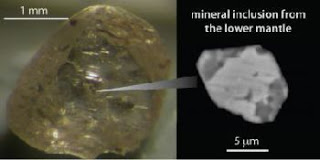
The carbon cycle, upon which most living things depend, reaches much deeper into the Earth than generally supposed-all the way to the lower mantle, researchers report.
The findings, which are based on the chemistry of an unusual set of Brazilian diamonds, will be published online by the journal Science, at the Science Express Web site, on 15 September. Science is published by AAAS, the non-profit, international science society.
“This study shows the extent of Earth’s carbon cycle on the scale of the entire planet, connecting the chemical and biological processes that occur on the surface and in the oceans to the far depths of Earth’s interior,” said Nick Wigginton, associate editor at Science.
“Results of this kind offer a broader perspective of planet Earth as an integrated, dynamic system,” he said.
The carbon cycle generally refers to the movement of carbon through the atmosphere, oceans, and the crust. Previous observations suggested that the carbon cycle may even extend to the upper mantle, which extends roughly 400 kilometers into the Earth. In this region, plates of ocean crust-bearing a carbon-rich sediment layer-sink beneath other tectonic plates and mix with the molten rock of the mantle.
Seismological and geochemical studies have suggested that oceanic crust can sink all the way to the lower mantle, more than 660 kilometers down. But actual rock samples with this history have been hard to come by.
Michael Walter of the University of Bristol and colleagues in Brazil and the United States analyzed a set of “superdeep” diamonds from the Juina kimberlite field in Brazil. Most diamonds excavated at Earth’s surface originated at depths of less than 200 kilometers. Some parts of the world, however, have produced rare, superdeep diamonds, containing tiny inclusions of other material whose chemistry indicates that the diamonds formed at far greater depths.
The Juina-5 diamonds studied by Walter and colleagues contain inclusions whose bulk compositions span the range of minerals expected to form when basalt melts and crystallizes under the extreme high pressures and temperatures of the lower mantle.
Thus, these inclusions probably originated when diamond-forming fluids incorporated basaltic components from oceanic lithosphere that had descended into the lower mantle, the researchers have concluded.
If this hypothesis is correct, then the carbon from which the diamonds formed may have been deposited originally within ocean crust at the seafloor. A relative abundance of light carbon isotopes in the Juina-5 diamonds supports this idea, since this lighter form of carbon is found at the surface but not generally in the mantle, the authors say.
The diamond inclusions also include separate phases that appear to have “unmixed” from the homogenous pool of material. This unmixing likely happened as the diamonds traveled upward hundreds of kilometers into the upper mantle, the researchers say.
After the diamonds formed in the lower mantle, they may have been launched back near the surface by a rising mantle plume, Walter and colleagues propose.
Note: This story has been adapted from a news release issued by the American Association for the Advancement of Science










